#divided hennin
Explore tagged Tumblr posts
Text


wanted to share the medieval hennin that I made for the ren faire this weekend! I crafted it totally from scratch and i'm just really happy with how it turned out :)
(progress pics & steps in the reblog!)
#hennin#headdress#headpiece#medieval fashion#medieval#horned hennin#divided hennin#costume#sewing#fiber art#middle ages#medieval hennin#renaissance faire#renaissance festival#ren faire#historical fashion#theartofmadeline#i need to share this because im wildly proud of it teehee#i want to wear this every day not gonna lie#the outfit was not very 15th century but hey its ren#and i had fun!!!#double horned hennin#cosplay#textile#textile art
314 notes
·
View notes
Text
Fashion Across Etheirys Pt. 1: Ishgard
Reminiscent of Medieval Catholic France, Ishgard leans hard on this by doubling down on the aesthetic of their nobility. Meanwhile, the less affluent of Ishgardian society tend toward an English punk style or are just too poor to have the luxury of choice in style. Hilda and her leather jacket come to mind. There are, of course, the outliers like Stephanivien, who, while of noble descent and from one of the High Houses at that, wears a steam punk-esque engineer outfit due to work. Neo-Ishgardian garments also lean towards the steampunk aesthetic, which is more Victorian in nature but still very English. The other styles within Ishgard are more within the style of Medieval fantasy that's more in line with the Final Fantasy series, or are reminiscent of Catholic attire like that of the church priest's clothes and the Scholasticate coat.

Ishgardian fashion is one that brings to mind nobility, with their heavy fur coats made for the Coerthas cold and their tall pointy hats called hennins with that strip of cloth over them. Yet these, while traditional, do not make up the entirety of Ishgard’s fashion landscape. According to an interview run by an Eorzean Weaver, the rich and fashionable of Ishgard have begun to favor cavalier hats as well as doublets. [1]
This tendency towards the clothing of soldiers is on brand for Ishgard’s history and tendency towards war and battle, a fact made clear by their patron deity, Halone the Fury.
Ishgard only recently began to patronize the use of leather in their clothing, thanks in part to an Eorzean Leatherworker and the efforts of Elde, having previously favored metals such as steel and iron. A remnant of their more temperate climes before the Calamity had struck. However, with the cold now a permanent feature to Coerthas and her climes, cloth, and leather are gaining new traction. [2]
Their military fashion also resembles this love for iron and steel, favoring chainmail, giving their military a color palette of gray with the cloth padding showing beneath. Their dragoons favor emphasizing blue, with their armor designs including spikes in the off chance a dragon tries to swallow them and being closer to the body’s fit to allow for more time in the air to perform their fearsome jumps. Dragoons have a pattern on their armor reminiscent of dragon scales. The armor is designed and based on Haldrath, the first Azure Dragoon, a design that has been improved upon since then by the ever-militant Ishgard. They’ve managed to find a technique wherein they quench the Mythril in dragon’s blood rather than water to ensure it is lightweight yet durable. However, with the end of the Dragonsong War and the peace between Man and Dragon restored, this technique has been swapped for an old technique, making a comeback. By smelting the ore in dragon flame, it imbues itself with their magics, a technique that likely forged Haldrath’s own armor.
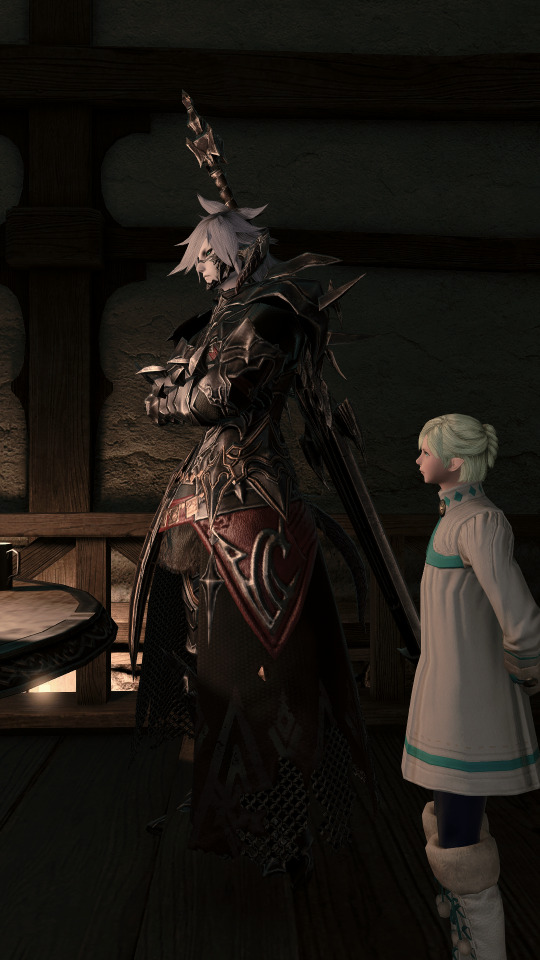
Dark Knights do not have this tendency for blue as the usual citizens of Ishgard. However, their armor takes many elements of Ishgard’s classical militia, from the dragoon’s iconic spikes to the chainmail and padding of their less decorated soldiers. In terms of their color palette, they keep to darker steel combined with bright reds. By combining the armor designs of the dragoon and the common soldier, they stand out from the crowd as one set aside from the class divide within Ishgard. Their armor is more than just the combined elements of the military of Ishgard. Having been refined in the Ishgardian art of metallurgy and smithing, they have thickened the plate while ensuring flexible chainmail around the joints, providing the Dark Knight with all the coverage and protection one would need when wielding the greatsword. Controversial, though these knights of the meek may be, they are still a part of Ishgard.
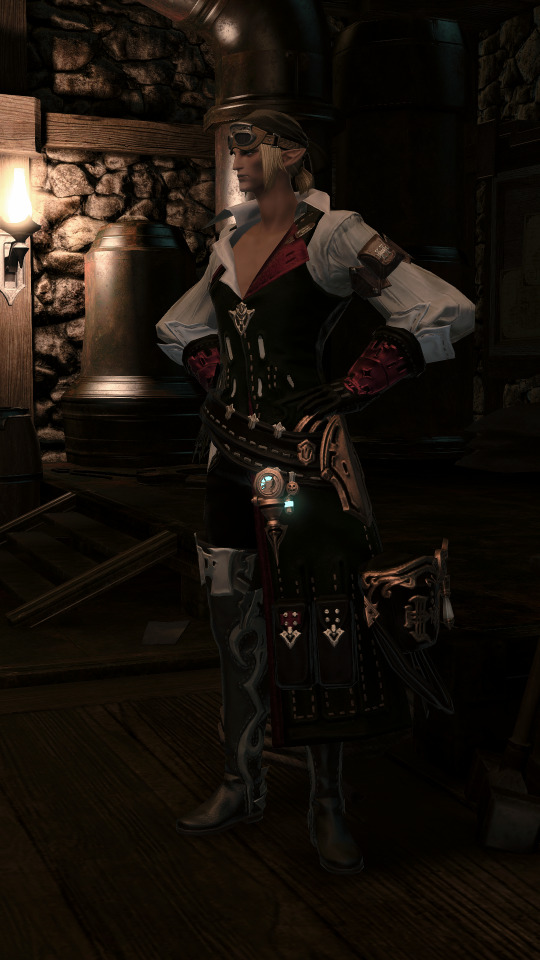
Machinists serve as a new part of Ishgard’s military thanks to the efforts of Lord Stephanivien of House Haillenarte. Because of this, they favor the clothing of Lord Stephanivien's work, utilizing a single long tail with a pouch for utility. Typically, Machinists also double as some form of engineer. Hence, they also favor goggles for eye protection, as well as thick gloves to protect the hands while working. The prototype of an upgraded version, titled "Gunner's armor," was conceived during the development of the uniform of Hilda's Hounds.
Merchants often present themselves cleanly, wearing a gentle blue color, as well as thick coats to help protect them from the cold while out hawking stalls or otherwise selling their wares. The women and men style themselves similarly, thick coats and sensible pants over the noble’s stricter gendered clothes of dresses and skirts. The more battle-ready of the nobles, though, tend to wear more suitable outfits such as a doublet with leggings and the like. Armor is also preferred if one is of high standing militarily, as in the case of Ser Aymeric de Borel. The military’s high standing is preferred over a noble’s usual high standing as it reflects the nobleman’s perceived duty to Ishgard.
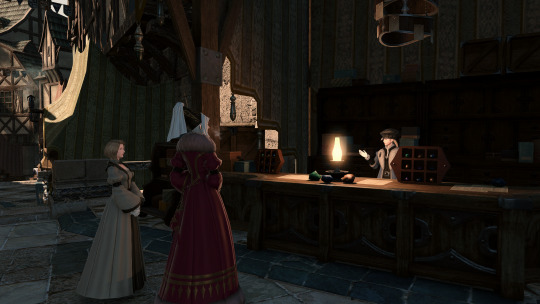
The upper class and nobility tend to wear brighter colors afforded to their class in the warmer shades of the spectrum. Yellows and reds reminiscent of Coerthas’ once vibrant greenery make the noble women stand out, while the men prefer a simple but not overstated color scheme of black and an accent color of their choice. Blue is for the more patriotic of the men, while red gives a man a bolder figure. Accent colors stay within black, gold, or brown to give the brighter colors a chance to shine. General notes in terms of Ishgardian fashion is the preference in keeping themselves fully covered as the weather of Ishgard allows for nothing less. The rich of Ishgard prefer to reflect that richness in the quality of the cloth, with brighter colors, detailed embroidery, and better keeping them from the cold. Those from the Brume keep to more practical aspects, rougher clothing, muted or lack of dyes, and less general freedom to wear fashions.
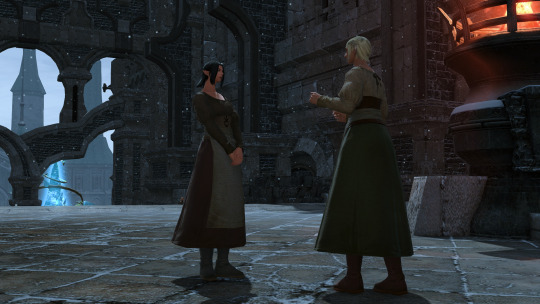
In comparison, the common folk wear clothing typical of their class and current placement in society. This is due to the class divide of Ishgard. Those from the Brume tend to wear less gentle fabrics, rough and rugged. Their outfits are typical of those suffering from poverty or those of a lower income. The workers of Ishgard tend to wear outfits that suit their job.
Special Mentions:

One cannot go to Ishgard without noting the heavy and deep influence of the Ishgardian Orthodox Church. In comparison to the color choices of the general layman in Ishgard, who wears blue as either the main statement color or to serve as an accent color, the church’s accent colors are red. Bright red, with the clergy wearing white whilst their seminarians, the students of the Scholasticate, wear black and red in the seminary’s classic coat.
1 From the Weaver Questline, the interviews tell you that the upper class has begun favoring cavalier hats and doublets. This is a common trend amongst most of the younger nobles as military accomplishment is important.
2 From the Leatherworker Questline, this is the major factor for why Elde struggled to bring leatherworking into Ishgard's clothing industry.
Note: Dragoon, Dark Knight, and Machinist got their descriptions from both observation and the Encyclopedia Eorzea II entries. The civilians were purely observation from looking at all the npcs, while the Special Mention is a minor discussion on the church-based attired of the Scholasticate and that of the Ishgardian Clergy.
If there are any inaccuracies lorewise, please feel free to correct me so that I can amend this! This is simply something I started because I figured this would be useful for me when doing outfits, then figured it would be best kept here. Thank you for reading!
4 notes
·
View notes
Text
Fantasy Wardrobe: Popular Headresses (Women) Part 1
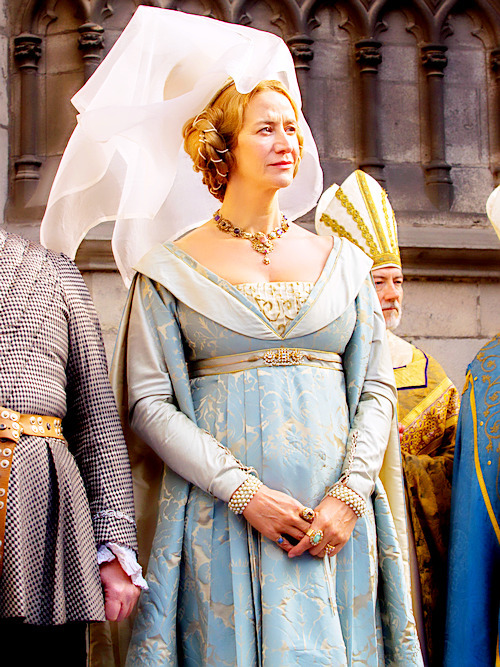
(Disclaimer: These are mostly European and from Mediaeval/Renaissance times. Other posts are coming about other periods and places so keep that in mind)
Fashion for ladies have changed throughout the centuries, no garment more so than the headdresses they wear. Statement headdresses can be an interesting component to add to your worldbuilding. The use of different styles give each culture a defined feel and could act as a symbol of all kinds of lands in your WIP.
Hennins
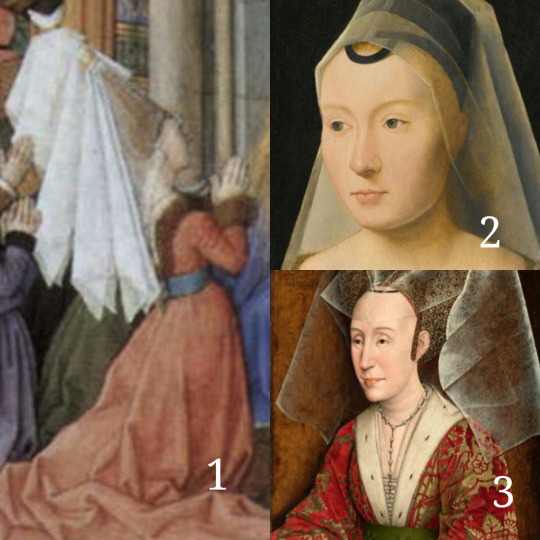
These are those headdresses. The ultimate headdress for a Princess. These headdresses made of stiffened material and draped with veils. They came in the popular cone shape (image 1), or the truncated shape/ flower pot (image 2) or the divided version (image 3). These were popular in the 15th Century, coming from the French courts and the Burgundian court.
Stickelchen Cap

This headdress was made up of a padded piece pinned to the hair, draped with a veil and topped with a heavy almost square-shaped cap usually heavily beaded and embroidered.
Wimples
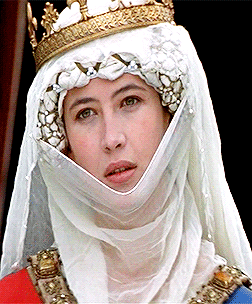
Wimples were drapes of material that covered a woman's hair, neck and sometimes her face. With its similarities to hijab, historians suspect that wimples might have been among the fashions that crusaders (dick-heads) brought back. Wimples were often worn to show modesty, with many nuns and religious women taking it as their signature look.
Balzo

These headdresses are circular rolls of materials fitted to be worn at the back of the wearer's head. They could be stitched with veils and precious stones.
Crespines/Cauls

These were popular for a long period of time, close to two centuries. These provided ladies with long hair to tidy it out of way. Women wore their hair on either side of their heads, held by thd crespines which could be made of mesh metal or cloth netting. The whole thing would be secured with a fillet, a length of material or metal fitted over the top of the head.
French Hood
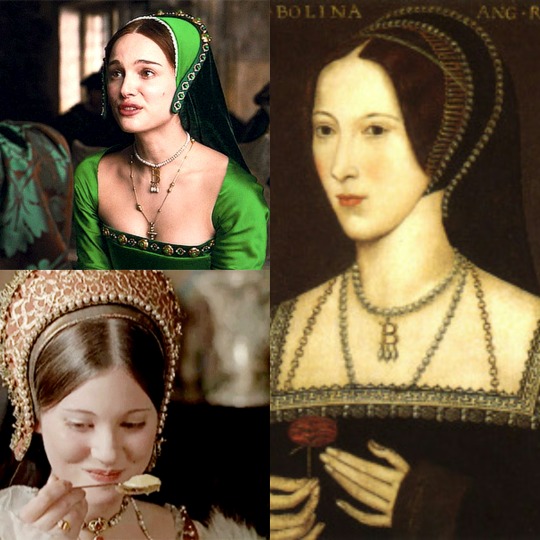
The French hood is a crescent shaped headdress that sits atop the head, allowing the front half of the hair to be shown. The back was always stitched with a veil. The front half of the hood wasn't a fucking hairband (calling out Wolf Hall) but rather a significant height usually bejewelled and embroidered.
English/Gable Hood
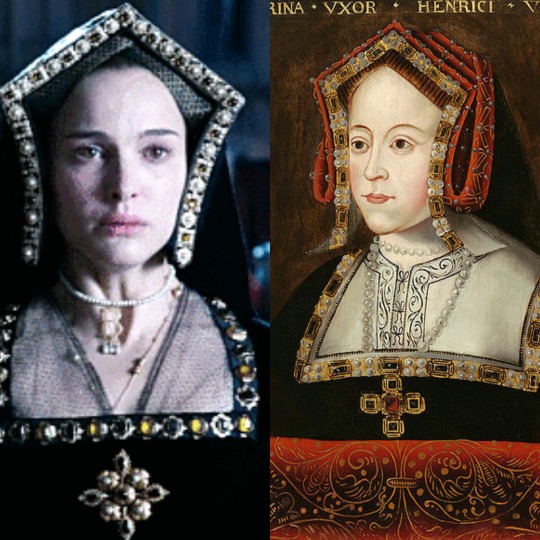
This sort of looks like a roof but a rather regal roof. The ancestor to the French hood, it was the favourite headdress of Katherine of Aragon and Jane Seymour. It has always been one of the more regal looking headdresses to me.
Kokoshnik
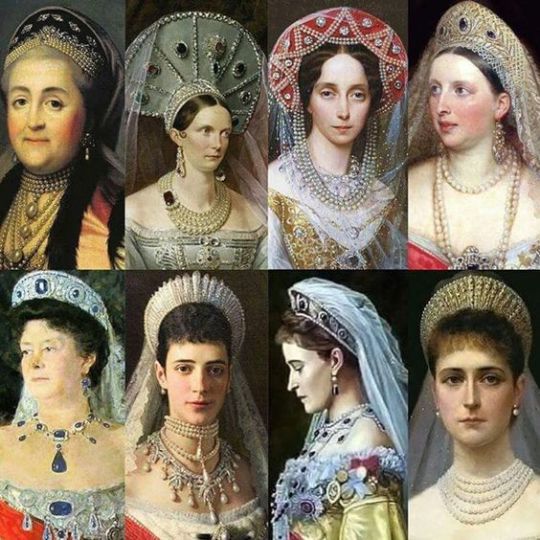
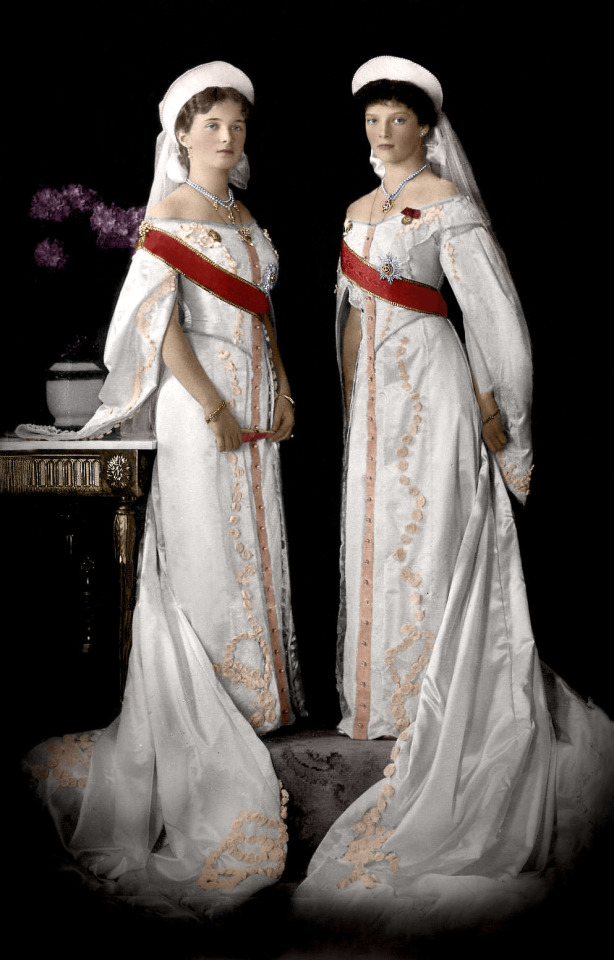
My favorite headdress of all time. It is Russian headdress of all different shapes, the most popular and common being the crescent shaped one. Most kokoshniks were accompanied by bands of beads or pearls laid across the forehead or a large bow at the back. I fucking love the kokoshnik.
#fantasy fashion#fantasy gown#fantasy#fantasy wardrobe#fantasy guide#woman's headdress 1#fashion#fantasy worldbuilding#worldbuilding#fantasy cultures#culture#kokoshnik#hennin#headdress#historical fantasy#historical#historical fashion#history dump#writes#writer#writing advice#writing advice writing reference#writing advice writing resources#writing resources writing reference#writing resources#writing resources writing advice#writing research#writer tips
3K notes
·
View notes
Link
Medieval fashion terminology

bliaud — overgown with either long, tight sleeves or looser, elbow-length sleeves


braies/slops — short pants gathered and tied at the waist and tucked into hose (men)

butterfly— starching veils and shaping them using wired, worn over headdresses (women)

caul/snood/crespinette — a net, usually of gold or silver, used to hold up hair, often lined with fabric (women)

chainse — under-tunic, often belted with leather or cord and worn alone in warm weather

chaperon — hood covering head and draped over shoulders

chatelaine — leather pouch or chain hanging from a belt that usually carried household tools, personal items, or coins

chausses — hose attached at the top (men)

coif — close-fitting headdress of white linen, cotton or silk that tied under chin, usually worn under other head coverings

cotehardie — tight-fitting tunic or gown

cottes historiées — family’s coat of arms emblazoned on garments in embroidery or appliqué

crackowes/poulaines — soft, pointed shoes, often wooden-soled, sometimes with the toes held up by gold chains attached to the knee if they were long enough

cyclas — sleeveless tunic worn with or without belt

dagging — ornamental cutting of fabric edges, applied to all manners of clothing

dalmation/angel sleeves — large, voluminous sleeves

escoffion — double-pointed headdress (women)

gorget — square of fabric draped under chin to cover neck (often accompanying the wimple) (women) [This term can also refer to a piece of armor covering the neck]

hennin — high, pointed, conical headdress that imitated the Gothic church spire, often with veils attached to them (women)

houppelande— long, voluminous coat with sleeves sometimes lined or trimmed with fur

justacorps/pourpoint/jupon — quilted garment similar to a vest or jacket (men)

liripipe — long, trailing point often added to a hood or headdress

mantle — cloak worn over clothes, sometimes lined with fur or with a hood

particolored — garments divided into sections and sewn in contrasting colors

pelicon — fur lined robe, usually made from large piece of fabric with holes cut for the head and slits for arms
points/tapes — small laces that tied hose up to slops or braies (men) [see the images for braies]
ruching — pleating or gathering

sugarloaf hat — tall, rounded hat (men)

surcoat/robe — outer tunic

tabard — scoop-necked surcoat often open at the sides (men)

tappert — German coat padded at the shoulders, usually with slashed and cuffed sleeves (men)

toque/porkpie hat — hat with scalloped/pleated edges and an open top, attached by a chinstrap
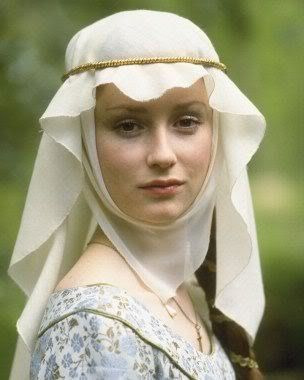
wimple/headrail/couvre-chef — kerchief draped over head and shoulders or over a cloth cap (women)
504 notes
·
View notes
Photo

(Zaskia Sungkar)
#i love the hat it's like a divided hennin kinda?#robes#witch hat#witch fashion#indonesia#asia#the queen of all colors
250 notes
·
View notes
Text
Information about the Courtiers
So, here we are. This is a huge post with all the information I could possibly gather about the Courtiers. The idea for this post was born out of sheer interest in this kind of stuff and the desire to know more about it, and I figured other people might as well be interested in it. Some of this might be far-fetched, so I would like to say that this isn’t a theory in any way, shape or form. It’s just a collection of information that caught my eye or facts that I found particularly interesting. Some parts involve me drawing conclusions or making assumptions. This is how I interpreted these things. You are allowed to disagree with me, but please be respectful. More might be added to it at a later date. If you see anything that isn’t correct (including typos/spelling mistakes), or would like to add to this, make sure to contact me! If you’re missing something here and have a question that you would like answered or a thing you want to see explained, don’t hesitate to shoot me a message either. Finally, I would like to thank @gummy-vitamin-gobbler for being my proof reader. I honestly didn’t want to put anyone through reading this entire thing and I’m super grateful you volunteered. You’re the best <3 Proceed with caution as this text does contain spoilers! This post is in alphabetical order based on their names, with a few general facts at the bottom of it.
General information Vesuvia’s royal court consists of five members. Their titles were given to them by Lucio when he became the Count. As reported by Valerius, the other four Courtiers were present on the night of the murder outside of Lucio’s room, thus making them key witnesses. Quaestor Valdemar is the palace’s head physician and Julian’s former boss. They seem to be obsessed with the Red Plague and delight in the chaos the disease brought to the city of Vesuvia. Not much more is known about them. Consul Valerius, as his title suggests, is a consul to the royal Palace and reportedly a key witness to Lucio’s murder. A tarot reading done by the apprentice reveals that Valerius has his own agenda, despite seeming supportive of Nadia and her aims at first. Praetor Vlastomil, besides serving as a judge, was Lucio’s business partner. He is an eccentric man obsessed with insects, particularly with worms, and has entire rooms dedicated to them at his manor. Procurator Volta is in charge of the city’s food supply and was essential during the Plague according to Nadia on account of her being able to smell the Plague off of people and other things. She is always hungry and never seems to be satisfied. Pontifex Vulgora is described by Nadia as a warmonger who has won many battles in Vesuvia’s name. They are extremely aggressive and obsessed with destruction, often threatening others. Quaestor Valdemar Name • Valdemar is a Scandinavian masculine name that finds its origins in the Old High German name Waldemar. It consists of the elements wald (meaning “to rule”) and mar (meaning “fame”). This German form was introduced to Scandinavia as Valdemar in the 12th century with King Valdemar I of Denmark. It’s particularly famous for being the name of many Scandinavian monarchs, and is sometimes considered to be the equivalent of the Slavish name Vladimir (meaning “of great power” or, in folk etymology, “ruler of the world”). The Old Norse form is Valdamarr (or Valdarr), which occurs in many tales and sagas. Title • A quaestor, back in Ancient Rome, was a public official. The term quaestor translates to “investigator”. The position served many different functions that differed per time period. In the Roman Kingdom, the quaestores parricidii (quaestors with judicial powers) were appointed by the king to investigate and handle murders and capital crimes. Headdress • The type of wrapped, horned headdress Valdemar wears is called a hennin. It was worn by European women of nobility in the late Middle Ages, and although it’s not clear what distinct styles of headdress the word hennin specifically referred to at the time, it has been recorded to be used in France as far back as 1428. However, the word wasn’t used in the English language until the 19th century. There are many different styles, such as the conical hennin generally accompanied with a veil (which is called the cointoise), the escoffin (a more heart-shaped hennin), the truncated hennin (with a flat top), the divided hennin (which was often covered in white cloth), the beehive hennin and the related Lebanese tantour headdress. The particular style worn by Valdemar seems most inspired by the butterfly hennin (thank you for this suggestion @gummy-vitamin-gobbler!) Appearance • As stated on the Arcana Wiki, Valdemar has dirty blonde hair (as can be deducted from the color of their eyebrows) and red eyes with slit pupils, like a cat. It is to be noted that their facial structure seems very similar to that of Nadia (and her sisters), with the same nose shape and eye color, and what seems to be the same skin undertones. It is a possibility that Valdemar is from Prakra. They wear a white lab coat with an overlapping mandarin collar on which they wear their beetle brooch, shoulder length gloves, a black waist apron and a white surgical mask. While there is no existing labcoat design that looks like Valdemar’s, the buttoning style is somewhat similar to the “Howie” style lab coat, although it might be a bit of a stretch. This is a variant of the basic lab coat adopted for the added safety. The Howie coat was named after J. W. Howie, who was the President of the College of Pathologists. This style has the buttons on the left flank, elasticated wrists and a mandarin collar. Tarot card • The card Valdemar represents is Death. Death is ruled by Scorpio, suggesting that their zodiac sign might be Scorpio. There is, however, a discrepancy at play here, considering Valerius’ sign, which we will come to later. The number of the card is 13, which is a number sacred to the Goddess as there are 13 full moons in a year. In Asra’s tarot deck, Death is portrayed by a skeleton horse. It’s not clear whether Valdemar represents the upright or reversed card meaning. Considering Valdemar’s seeming inability to let go of the Red Plague and desire for it to return, one might argue they represent Death Reversed. In traditional decks, Death is often portrayed by an armored skeleton riding a white horse and carrying a banner. The armor is symbolic for the fact Death is invincible and unconquerable - no one can triumph over him. The white horse stands for purity, as Death is the ultimate purifier, and doesn’t discriminate between age, race or gender. This card is probably the most feared and misunderstood out of all of them, as people often take the meaning of it far too literally. Upright, it is actually a positive card that stands for significant transformation, change, transition and new beginnings. Reversed, Death reflects reluctance to let go of the past and a refusal to accept change.
Consul Valerius Name • A masculine name of ancient Roman origin. This was a patronymic family name derived from the Latin valere “to be strong” or “to be healthy”, and was the name of several early saints (this ties in with him representing the Hierophant card). The Valerius family was prominent from the very beginning of the Republic to the latest period of the Empire, and a lot of its members were among the most celebrated statesmen and generals. This even went as far as several of the Roman emperors claiming to be descendants of the Valerii. It’s also to be noted that there were a lot of consuls who bore the name Valerius. Valerian is also an herb with sweetly scented pink or white flowers that has sedative and anxiolytic effects. The name of the herb is derived from the verb valere, just like the name Valerius. It has many other names, one of which is all-heal. This name is also used for plants in the genus Stachys, although one of the nicknames for this specific plant is lamb’s ears. Nicholas Culpeper, a seventeenth century astrological botanist, said that the herb was of special value against the plague. Title • Consuls, back in ancient Rome, were magistrates comparable with prime ministers or presidents. Apart from the oldest, it was also the most important position in the cusus honorum or “course of offices”. Consuls always came in pairs and served for only one year to prevent corruption. They were the chairmen of the Senate (which served as a board of advisers), commanded the army and exercised the highest juridical power in the Roman empire. Consuls had the right to interfere with the decisions of praetors and quaestors. Appearance • Notable about the Consul’s clothing is the golden ram brooch he wears on his shawl. In the tarot deck used in The Arcana, The Hierophant is represented by a ram. Valerius is also the only courtier who doesn’t wear a red beetle brooch, so this makes it an exceptionally remarkable feature. Valerius wears his ombre hair French-braided and draped over his shoulder. Ombré, literally meaning “shaded” in French, describes the gradual transition from one hue to another, usually from dark to light or vice versa. Ombre was popular in fabric printing as far back as the early 19th century. His underclothing seems to consist of what is either a jumpsuit-like one piece or two separate pieces with gold trim on the cuffs and collar. On top of this he wears an asymmetrical, taupe, frock-inspired, tunic-like overcoat with three-quarter bell sleeves, a golden cord in the front and what seems to be some kind of button and loop fastening, also called “frog fastening” or “Chinese frog”. This is a type of ornamental braiding of sorts consisting of a button and a loop and serves for fastening the front of a garment. This particular type of closing is often found on clothing of Asian design. Frogging was also a popular type of fastening for military uniforms from the 17th to the 19th century. His shoes have gold decoration, red soles and spool heels. The hand that Valerius keeps near his body also seems to be lighter than the rest of his skin, leading me to believe he wears a glove on this hand. Tarot card • The card Valerius most likely represents is The Hierophant. The Hierophant, in Asra’s tarot deck, is depicted as a ram. Valerius’ ram brooch seems to allude to a connection between the two. There is however one problem concerning this theory, namely that The Hierophant is ruled by Taurus, and not by Scorpio, which happens to be Valerius’ canon zodiac sign. This would make him the only known character in the entire story representing a card that does not match their zodiac sign. The card’s number is five and it is commonly depicted as a religious figure sitting on a throne. The three elaborate vestments of his office that he wears represent the three worlds. He wears a crown and his right hand is raised in benediction - this is the same hand that the Magician has raised, but where the Magician draws raw power from the universe and manifests it on the material plane, the Hierophant channels his power through society (in the form of religion). The crossed keys of the Hierophant represent a balance between the conscious and subconscious mind, and are used to unlock mysteries. Upright, the Hierophant means religion, group identification, conformity, tradition and beliefs. Reversed, it means restriction and challenging the status quo. What is interesting to note is that the Hierophant is also known as the Pope, the High Priest (as a masculine counterpart to the High Priestess), the Shaman, and Chiron. Chiron is a comet with an erratic orbit. In astrology it symbolizes the “wounded healer” in the natal chart. Chiron represents our deepest wound and our efforts to heal it. In Greek mythology, Chiron was a centaur who was a healer and teacher who ironically enough could not heal himself. The symbol for Chiron is a key, much like the keys that the Hierophant himself holds, used for unlocking secrets. The wounds of a Chiron in Scorpio native are nihilism, sexual addiction, power struggles, jealousy and obsession and trouble leaving bad relationships. Praetor Vlastomil Name • While Vlastomil isn’t an actual name (I know, I was surprised too), Vlastimil is. It’s a common Slavic masculine name consists of the elements vlast (meaning “homeland”) and mil (meaning “favor”). This however is the modern meaning of these words and it should be said that they are derived from volsti (power, government, rule, sovereignty) and mil(a) (kind, loving, and gracious). The Latin form of this name is Patrick (I have no idea how). Patrick can be found as a name derived from the Latin Patricius, which means “nobleman”. Title • Praetors served as judges of the Roman Republic and, in the absence of the consuls, commanded armies. It was a title granted by the government and was inferior only to senators and consuls. One could only become a praetor after serving at least one term as a quaestor. The Praetor Urbanus acted as the chief administrator of Rome and wasn’t allowed to leave the city for more than ten days. They were the main magistrate responsible for trying the people of Rome. Hat • Vlastomil’s feathered cap is called a beret. It is a soft, round, somewhat floppy, flat-crowned hat for both men and women that originates in France and Spain. It fits snugly around the head and can be shaped in a variety of ways. There are many different styles of berets and aside from it often being seen as headgear in the military it was very much beloved by European nobility and artists throughout history. The Basque style beret, which is probably the most well-known and most simple style of all, was first commercially produced in the very South of France in the 17th century. The beret that Vlastomil wears seems to be inspired by berets worn during the Renaissance, and in particular those worn by the German Landsknechte. The Landsknechte (a word combining land “land/country”, here in the sense of “lowlands”, and knecht “servant/vassal”, here in the sense of “foot-soldier”) were mercenary soldiers who were an important military force in Europe during the 15th and 16th century, consisting mostly of pikemen and foot soldiers. They wore large, slashed berets (sometime referred to as starfish hats) that, when puffed out, showed a different color fabric underneath, and were adorned with big feathers. Although it doesn’t have much to do with the hat on itself, it should be said that the Landsknechte had a reputation for unprincipled, ruthless violence and were infamous for the fact it wasn’t unknown for entire regiments of Landsknechte to swap sides in the middle of a battle if they were offered more money or to desert en masse when there was no more gold to pay them. Appearance • Vlastomil has grey hair and white eyes with slit pupils, much like the other Courtiers minus Valerius. A very striking feature is his one visibly pointy ear with a golden earring in his stretched earlobe. There seems to be another gauge right behind the first one, but he doesn’t wear any jewelry in it. He wears a gown that is most likely inspired by traditional ceremonial court dresses/judicial robes, although I don’t know enough about these to be able to determine which one exactly it is most similar to. The open puff sleeves with white insets are reminiscent of the slashed style of his beret. They seem inspired by the paned sleeves that were popular during the 15th and 16th century European Renaissance. Furthermore he wears fabric chausses, worn in the 14th century when they served as leg armor made from chain maille. These could extend to the knee or cover the entire leg. Tarot card • Vlastomil’s card is Justice, ruled by Libra and bearing number 11. It was in fact confirmed by the devs that Vlastomil’s zodiac sign is Libra. In Asra’s deck, Justice is represented by a boar. The traditional depiction is that of Lady Justice sitting in a throne, holding a sword in her right hand and her scales in the left. The sword signifies impartiality and victory, and the scales show that logic must be balanced by the intuition, as the left hand is the intuitive hand. It is to be assumed that Vlastomil represents the reversed meaning of Justice. Justice upright symbolizes fairness, truth, cause and effect and law. Reversed, it stands for unfairness, lack of accountability and dishonesty. Considering the Praetor’s course of action during Julian’s trial, it’s evident why he would be Justice Reversed. The card shows an unwillingness to understand, refusing to take responsibility for one’s actions and blaming others for your mistakes. It reflects a very judgmental, biased, black-and-white view of the world and under-handed behavior, all of which is incredibly dangerous while swinging the sword of justice. Procurator Volta Name • Volta isn’t an actual given name either, but there are a lot of things that is is. In a poem, the volta, or turn, serves as a rhetorical shift in thought and/or emotion. It has gone by many different names such as fulcrum, modulation, torque, swerve. Leslie Ullman called the volta the poem’s “center”, which is largely the poem’s dramatic and climactic turn. Phillis Levin said that “we could say that for the sonnet, the volta is the seat of its soul”. It’s interesting to note that the stomach was once thought to be the seat of the soul, instead of the heart or the brain (particularly in Buddhism if I am not mistaken). The Volta also a quick-moving Italian dance that was mostly popular during the 16th and 17th centuries. Title • Procurators were officials who were in charge of the financial affairs of a province in ancient Rome. Although they worked alongside the imperial governor they were not subordinate to him and reported directly to the emperor. The procurator had its own staff and agents and had a few primary responsibilities, such as the collection of taxes and rents and the distribution of pay to public servants. Headdress • The headdress Volta wears is a cornette, which is essentially a type of wimple. A wimple is a large piece of cloth worn around the neck and chin and covering the top of the head. The wimple was popular in early medieval Europe, where during many stages of medieval Christian culture it was unseemly for a married woman to show her hair. Originally the wimple was creased and folded in prescribed ways. Later, elaborated versions such as the cornette were supported by wire or wicker framing. Both the wimple and cornette are perhaps most famous as a headdress for nuns. Like the horned hennin, the cornette was folded in such a way as to create the resemblance of horns. In the mid-17th century, it was worn by the Daughters of Charity: a Roman Catholic society consisting of women that took care of the sick and poor and attempted to resemble ordinary middle-class women as much as possible in their clothing. Appearance • Volta has curly, reddish-brown hair and brown eyes, although one of them is invisible due to what seems to be a lazy eye. One sharp snaggle-tooth sticks up from her bottom row of teeth. She wears what seems to be some sort of nun dress, or a habit, which were traditionally plain garbs worn by members of a religious order. The reason for this uniform outfitting was that nuns and monks had to be recognizable as such. Considering the cornette Volta wears (which is tied to the Roman Catholic society Daughters of Charity as explained above), it is most likely that her dress was based on the typical Roman Catholic habit. Ironically enough, the habit was a symbol for living a sober life in poverty and consecration, all of which seem to be the opposite of the tarot card Volta represents (as described below). Her dress has puffed sleeves and, considering the shape of it, probably an empire waist. Her shawl is clasped in the front by her beetle brooch, and she wears what seems to be a tasseled fabric and a lace fabric draped over her dress. Finally, she wears fingerless lace gloves. Tarot card • Volta represents Temperance Reversed, as seen during the lunch scene with Vulgora and Volta in Nadia’s route where the apprentice can read the cards for one of them. Its number being 14, it is ruled by Sagittarius; traditionally the teacher of truth, enthusiasm, tolerance and beauty. In Asra’s deck, Temperance is depicted as a dove, but traditionally it is a winged angel we can see on the card. The angel, being a child of Hermes and Aphrodite, is both male and female, symbolizing a balance between them. One foot stands on dry land (the material world) while the other stands in the water (the subconscious). It represents a need to “test the waters” before jumping headfirst into unknown circumstances. The angel carries two cups with water that are being mixed, thus mixing the sub- and super-conscious minds. Upright the card means balance, moderation, patience, purpose and meaning. Reversed it is imbalance, excess and lack of long-term vision. As Volta is known to be extremely hungry and greedy when it comes to food, it’s clear what the element of imbalance and excess is. This conflict creates a lot of stress and tension. Temperance Reversed is also about people you are dealing with proving to be uncooperative. It may feel as though your interests are in conflict or competition with each other, and solving this may seem like an impossible feat. Although not consciously, one might still realize something isn’t quite right, and it may lead to role reversal. Pontifex Vulgora Name • In Roman mythology, Fulgora was the female personification of lightning. She is a minor goddess and the Roman equivalent to Astrape. Astrape was a shieldmaiden of Zeus, and was given the task of carrying his thunderbolts together with her sister. She is described as “flashing light from her eyes, and raging fire from heaven that has laid hold of a king’s house”. There isn’t a lot of information to find on her, sadly. Another possible origin for Vulgora as a name could simply be the word vulgar, meaning “not suitable, simple, dignified or beautiful” or “rude and likely to upset or anger people”. Title • The pontifex (literally “bridge builder”) was a member of a council of priests. The college of the pontifices was the most important Roman priesthood, responsible for regulating the relations of the community with the deities recognized by the state, called the jus divinum. They fulfilled duties such as for example regulating expiatory ceremonials needed as the result of pestilence or lightning. The pontifices were probably advisors of the king in all matters of religion and all held office for life. Headdress • Like Valdemar, Vulgora wears a hennin - albeit a perhaps somewhat more historically accurate version without the fabric wrapping. Their headdress seems to be slightly more similar to an escoffin in general shape but features the same horns as Valdemar’s hennin instead of the open-centered top a normal escoffin would have. Aside from that, their hennin is veiled with a sheer cointoise attached to both steeples. They wear a neck-covering wimple much like Volta’s, making their headdress into what seems to be a combination of these three styles. Appearance • Vulgora has red hair and yellow eyes with slit pupils. They seem to wear some sort of diamond-quilted knee-length tunic with a fabric waist tie and a tasseled golden rope on top. The red-and-gold striped, puffed sleeves are alike in size to gigot sleeves. Introduced to the English court by Anne of Cleves (one of Henry VIII’s wives), these sleeves were extremely wide over the upper arm and narrow from elbow to wrist. Once more, and much like the clothing of the other courtiers, Vulgora’s garbs seem to be Renaissance-inspired in design; specifically by the Tudor clothes worn during the reign of Henry the Eighth. Back then, the type of tunic Vulgora wears was also called a petti-cote; technically a waistcoat with sleeves. Furthermore, they wear a skirted, somewhat flaring, sleeveless cloak lined with gold near the bottom. These particular pieces of clothing were worn to make physical proportions appear larger, with padded shoulders and stuffed sleeves enlarging the figure. This was done to accentuate manly features that made the wearer appear bigger and stronger. It is hard to tell what the lower half of their arms might look like considering the clawed silver gauntlets they wear. Gauntlets like these were worn as armor, made out of hardened leather or metal plates protecting the hand and wrist. An interesting fact is that the term “gauntlet” is used in the idiom “throw down the gauntlet”, meaning “to issue a challenge”. A gauntlet wearing knight would challenge another to a duel by throwing one of his gauntlets on the ground. Picking it up meant that the challenge was accepted by their opponent. Tarot card • The card Vulgora represents is The Tower upright. It is ruled by Mars (the planet named after the god of war), which in turn rules Aries and Scorpio. It is assumed Vulgora is an Aries to tie in with their theme of war and strife. Its number is 16. In Asra’s deck, the Tower card shows a stag surrounded by red beetles (also note that Vulgora’s masquerade mask was a red stag beetle mask). Traditionally it is depicted by a tower aflame, tormented by lightning strikes. People are seen leaping off of it in desperation, fleeing from the destruction and turmoil. The Tower is generally one of the more negative cards in the deck. It signifies physical darkness and destruction as opposed to spiritually, and represents ambitions built on false premises. It is however important to note that the destruction of the tower also signifies the creation space for something new to grow in a sudden, momentary glimpse of truth and inspiration. Upright the Tower means disaster, upheaval, sudden change and revelation. Reversed it symbolizes avoidance of disaster and fear of change. The Tower is about the destruction of inadequate foundation of false thought, belief and action. It is humbling, frightening, but necessary. It is often descriptive of a major upheaval, disruption, emergency or crisis, and is likely to bring chaos in the aftermath of such an event. Only after this will come change and regeneration. Beetle brooches All courtiers, except for Valerius, wear a red and gold beetle brooch on their clothing. As we know, these pieces of jewelry are shaped after the red beetles that are occasionally seen and mentioned in the story. They are found in a specific room in Vlastomil’s manor, as well as burrowed in the ground beneath a spring nearby Nopal and kept in a well by Valdemar in the dungeons beneath the palace. Nadia mentions that the beetles were once used to dye fabric a bright crimson red, and in Asra’s route, a local named Saguaro tells a story of how a giant red beetle was once defeated by Lucio before turning into thousands of smaller red beetles that then hid in the ground. Finally, the red beetles appear on the Tower card in Asra’s deck. They seem to play a significant role in the spreading of the Red Plague. Judging by the general shape of the beetle, it is assumable they are based on scarabs. Scarabs held great meaning to the people of Ancient Egypt, who saw the them as symbols of creation, life, rebirth and immortality. The scarab-headed god Kephri was responsible for rolling the sun across the sky every day, where it died at night and was reborn in the morning. The sacred beetle also had protective abilities that they lend to its wearer. The scarab beetle was also sacred to Khepera, the god of creation, resurrection and immortality (all of which seem to allude to Lucio, the ritual, the apprentice and perhaps the Arcana). It is a highly spiritual bug that carries messages that bring our attention to renewal, spiritual maturity, and the powerful influences of the invisible side of life. When a person died, it was believed that their heart was weighed by Ma’at, the goddess of truth. If the heart was heavy with sin, the spirit of the deceased was not allowed to move on to the after life. In an attempt to convince Ma’at that a person was good and deserved her mercy, scarab beetle amulets were placed over a mummy’s heart. With the update of Lucio’s tale I feel like it’s safe to draw a few careful conclusions here. Lucio is from a wartribe referred to as the “scourge of the South”, depicted as red beetles on the tapestries that tell their tribe’s story, and referred to as “the swarm” by Lucio himself. In fact, Lucio describes his tribe as “a plague of voracious beetles, leaving nothing but bare bones in our wake”. It must be noted that the beetles kept in a well in the dungeons by Valdemar were used to dispose of the bodies of their deceased patients, as the insects were “[...] so effective at disposal” according to them. It is hinted that Lucio contracted the Plague from a beetle bite while fleeing from his mother after he failed to kill her. As stated previously in the story, the Plague is directly tied to Lucio’s life and will follow wherever he goes - as are the last words of his tale. The Four Horsemen In my previous Arcana plot theory post, I mentioned and quickly explained the Four Horsemen theory. While you could go and read it there I will here once more explain what exactly this theory is about. Quite a while ago when the Valerius sprite first was released, the devs jokingly mentioned that the Courtiers were the Four Horsemen of the Apocalypse and that Valerius was the fifth Horseman. While I do not remember the precise context or interactions that took place, this was the gist of it. At multiple points in the story it is mentioned that the Courtiers (minus Valerius) are not exactly human, or as not perceived as such by the apprentice. They are frequently described as “[having] a presence like a dark chasm” (Valdemar), a “beast” (Volta) and “not necessarily human” (Vulgora). Last but not least, Vlastomil’s manor is described by the apprentice as “confusingly designed [with] doors that lead to nowhere [and] halls that suddenly stop in dead ends, as if the manse itself were trying to disorient us” (Nadia’s route: Book VIII). It seems as though the four Courtiers represent the Horsemen of the Apocalypse. This idea is now further supported by the wyrm in Lucio’s tale introducing himself as “the worm of pestilence”. The Four Horsemen of the Apocalypse are described in the Book of Revelation - the last book of the Bible’s New Testament. The chapter says that God holds a scroll in his right hand that is sealed with seven seals. The Lamb of God, or Jesus Christ, opens the first four of the seven seals, which summons four beings that ride out on a white, red, black, and pale horse. The four riders are called Pestilence (on the white horse), War (on the red horse), Famine (on the black horse) and Death (on the pale horse). The colors of the horses also match the color schemes of the Courtiers. The Four Horsemen, as harbingers of the Last Judgement, set a divine Apocalypse upon the world. We can now with (near) certainty say that Vlastomil is Pestilence, Vulgora is War, Volta is Famine and Valdemar is Death. During the Last Judgement, the dead will rise from their graves after which the Second Coming of Christ (the Lamb of God) occurs. Everyone will then be judged, and will “receive what they deserve” depending on how they have lived their life. What goal this serves story-wise we can’t say just yet.
102 notes
·
View notes
Photo
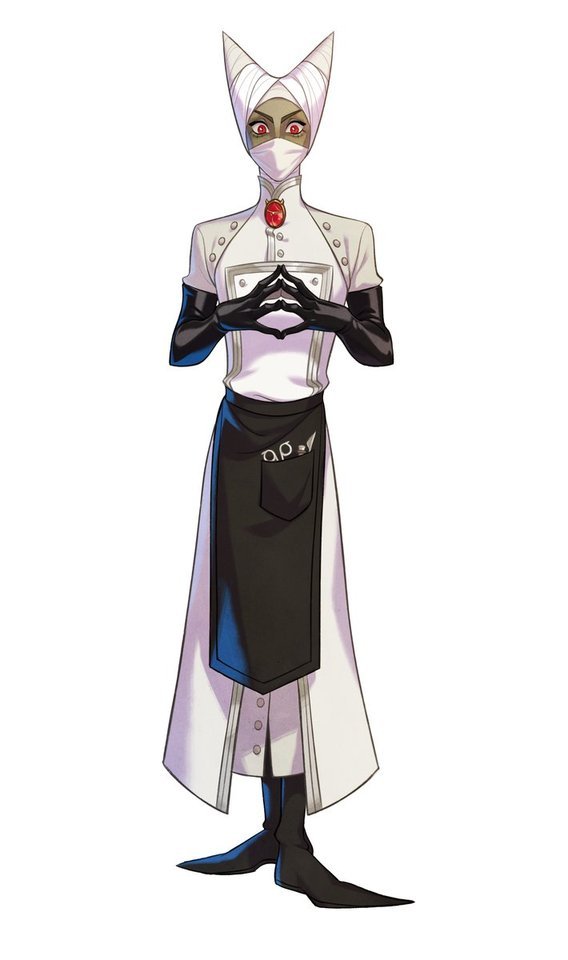

I’ve been working for a while on a Valdemar cosplay, and I finally finished their headpiece! This ended up being way trickier than I'd anticipated, but I'm glad I stuck with it!
After not being satisfied with my first attempt at it using foam, I came across this tutorial a medieval reenactor shared for the divided hennin she made which turned out to be exactly what I needed.
The horns are sewn to this ribbed elastic fabric I found, which I used to essentially make a swim cap
4 notes
·
View notes
Text
Tolkien Week day 05: Gear Up! DIY Gandalf’s Hat
Ever since I saw Alan Lee’s illustration on the cover of a LOTR edition, that hat has been engraved in my mind. I was so happy to see it in the movies, and the costume dept really took a lot of care to reproduce it in all of its awesomeness. So for this Tolkien Week I decided to give my geek fandom loving dolls a mini Gandalf hat!
I’m not the most expert miliner in the world though. I do pretty well with modern big ass boho hats, but I’m still perfecting my hennins and haven’t tried my hand at other period or fantasy creations yet. So, first of all I looked for a tutorial, and I found the video below:
youtube
Above: Gandalf The Grey Hat - How To by Zab on youtube.
It’s a great and very detailed tuto, very easy to follow. We just scaled the measurements to fit the Nu Face doll who’ll be wearing the hat. Each doll comes with their own factory hair, which is often glued to the head to preserve the hairstyle. Which leads to the fact that, in order to sew a hat for any doll you gotta measure that specific doll’s head. Otherwise the hat might simply not fit or get too large. In the end, it’s not different from doing a bespoke hat, measured for your own head. Only it’s done in 1:6 scale, so up the bespoke hat game level a bit for the mini measuring!
My material list below is for a doll sized hat only guys, so if you’re doing the hat for yourselves, follow the guidelines of the video tuto ok?
You’ll Need:
Scraps of gray wool - lightweight to medium weight.
A Scrap of fusing
A tiny bit of pillow filling (optional). Depends on the wool weight.
Scissors both for paper and fabric
pins
Iron
a bit of cord
measuring tape
compass (if your measuring tape doesn’t have a hole on the tip)
needles and gray yarn (I wouldn’t try this on the sewing machine guys. It’s too small IMHO. If you decide to try, please let me know how it went.)
paper to draw the patterns and a sharpie, pencil or your patternmaking weapon of choice.
Making it happen:
1 - Pattern Making:
Well, now we follow the instructions on the tuto and adapt when necessary. First to make the brim for a doll you’ll need to measure around your doll’s head. That can be tricky using a measuring tape. So, you get a bit of cord, wrap around your doll’s head where you want the hat to sit in, mark where in the cord the ends meet around the doll’s head, then unwrap it and stretch the cord over the measuring tape to get the measurement!
Once you have the measurement, draw a circle with the value as it’s circumference, giving it a few extra inches, or else the hat will not fit your doll, or will sit straight on his/her head. I gave mine an extra centimeter (approx 1/2 inch), but it’s ok to give it a bit more if you want, since you can always adjust that after testing on the doll’s head. Then, plan your brim. How big do you want it? I planned my brim to have 3 cm (approx 1 1/5 inches) more than my first circumference. That makes it wide enough for a female doll with my doll’s proportions. I’d reccomend a bigger brim for a male doll depending on his own proportions. But I can’t precise now. I intend to make another one for one of my boys, so I’ll update this post when I get the exact measurements.
Anyway, once you’ve planned your brim, draw it as a concentric circle with your first one, with the desired circumference. Then cut the pattern and do as the lady in the tutorial says, and play with the shape around the doll’s head. Clip it a bit to change the shape, and have fun imagining the brim on your doll’s head and the shape you expect it to have while sitting on your doll’s head.
Once you’re done shaping the brim, it’s time to draw the cone. I used the same measurements given by the lady for hers. 21 inches. I just divided them by six. Once you have the proper height, follow the guidelines in the video: draw the height on the fold, and you have your center front. At the bottom, using the hole on the measuring tape, or a compass if your measuring tape is like mine, draw the curve of your cone. Then, use the inner circle of your brim to limit where the cone will close, connect the dots and your cone is ready.
Once you have your cone, again, follow the instructions on the video and drop the front a little bit, and draw another curve that merges with the original one in the back and matches the dropped center front too. I dropped my hat only 1/2 inch. You don’t need more for a doll. Then cut your pattern and cut it twice on the wool.

Above: My pattern pieces cut. Photo by me.

Above: My fabric pieces cut. Two for the outer layer and two for the lining.. Photo by me.
2 - Sewing
Well, i started the sewing process by making an adaptation. The first thing you have to do is applying the fusing to your fabric. According to the video, you apply the fusing to the wrong side of the outer fabric on the cone, and on the wrong side of the lining fabric on the brim so that it stays completely hidden in both cases. Problem is: my fusing is adherent on both sides and not only in one. Soooo I had to cut a third layer for my hat, this time in a thin cotton, to avoid leaving the paper on the fusing - which would make it harder to sew by hand - or leaving the glue exposed, which would certainly ruin the hat when I brought lining and main fabric together and they touched each other. Once that was done though, i just proceeded like she does on the video, and sewed the main fabric shut and then the lining, leaving a hole in the lining to turn the hat right side out later on.

Above: My main fabric shut. You can see the white cotton here covering the fusing on the cone. Photo by me.

Above: My lining fabric sewn shut. I don’t know if you can see the hole, but there’s a gap in the sewing. You can see the cotton here covering the fusing on the brim instead of the cone. Photo by me.
From here on, we followed the video straight on, no changes needed. We’ve joined outer and lining fabrics by the brim, matching the brim sewing, then we’ve turned the hat right side out, ironed it to help flatten, topstitched around both brim and cone for extra flattening, and here came the last bit of change. When we tried the hat on our doll’s head, we noticed the two layers of wool plys the cotton and fuding had already made the hat “fluffy” enough so in the end, there was no need to stuff it with pillow filling. It may not be the case for you guys, ‘cause it’s a matter of taste and of doll size. If you try this for a 16 inches’ doll or an American Girl doll, it will most likely be necessary. Also, even if you’re doing it for a 12′, your wool might be thinner than ours, or it might simply not be fluffy enough for your taste. So, keep that in mind and have some pillow filling ready just in case.
Et voilà! Here’s our hat! Better result photos on Hobbit Day!

Above:
My hat ready for Hobbit Day. Photo by me.
#tolkien#tolkien week#2018#tolkien diy#diy gandalfs hat#nintendo hard#youtube#youtube diy#youtube video#video diy#doll diy#doll sewing#doll milinery#doll hat making#gear up#larping costume#larp#larp in style#savage#savage af#have fun#get creative
10 notes
·
View notes